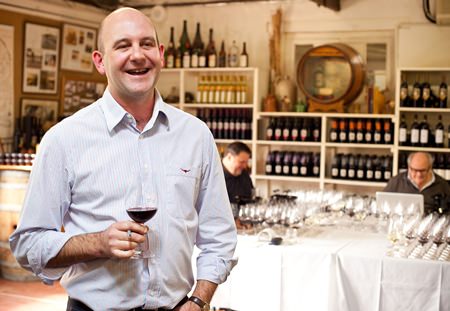If you were to head out of Adelaide, Australia’s fifth-largest city and drive with the thundering traffic on to the South Eastern Freeway, you’d find yourself passing close to places with reassuring and wholesome Olde Worlde names like Bridgewater, Totnes and Littlehampton. After a while, you could turn off to the quieter B37 through the thriving city of Mount Barker and on to the old town of Strathalbyn, lying on the banks of the modest River Angas. Turn left on to the B45, and you’re on Langhorne Creek Road and in a completely different world. There are oceans of vineyards and rows of trees pretty well as far as the eye can see. Driving along this quiet country road you’ll eventually arrive in the hamlet of Langhorne Creek. It’s a small place, but it’s the home to several world-class wineries and the centre of a vibrant grape-growing and winemaking community which regularly wins national and international awards. It sounds like we’ve come a long way from Adelaide but the journey down here to Langhorne Creek on the Fleurieu Peninsula takes less than an hour.
 Paul Hotker, Bleasdale’s senior winemaker
Paul Hotker, Bleasdale’s senior winemaker
In the 1840s, Frank Potts was in these parts too. He was a young Englishman living in Adelaide who decided to leave his boat-building trade and head for the country. He saw the potential of the region and was convinced that the tall red gum trees promised fertile soils. He bought the first parcels of land on the meandering, tree-lined Bremer River at Langhorne Creek and planted his first vines in 1858. By all account, Potts was a practical man with extensive skills in carpentry. He designed and built his own irrigation pump and aqueduct out of the wood from gum trees. He used the same wood to construct wine vats, barrels and casks. He even used it to make a five-seat communal lavatory which must have caused a great deal of merriment among the vineyard workers.
Perhaps his greatest achievement was a wine press, constructed in 1862 using a massive gum tree weighing several tons as a lever. A gum tree, by the way, is a kind of eucalyptus, so called because it exudes copious sap from any breaks in the bark. You may be interested to know that the same wood is used to make that odd-sounding honking thing known as the didgeridoo, a traditional Aboriginal wind instrument.
Frank Potts gave his wines the name “Bleasdale” possibly because he liked the preaching of a Reverend John Ignatius Bleasdale who advocated a “sober, wine drinking community in South Australia which excluded ardent spirits”. In the 1870s he handed the winery over to his son to resume his old profession of boat building, constructing paddle steamers and barges which plied the River Murray until after the turn of the century. For a long time, much of the region’s wines went into multi-regional blends. It wasn’t until the 1990s that a small group of long-term family growers started promoting Langhorne Creek wines, known best for Cabernet Sauvignon and Shiraz. Both these Bleasdale wines are imported by Foodland and so you won’t find them on sale anywhere else.
Bleasdale Bremerview Shiraz 2012 (red), Australia (Bt. 659 @ Foodland only)
The Bremerview vineyard lies on the banks of the Bremer River that flows just outside the town of Langhorne Creek. As you might expect from a Shiraz, this is a rich and very dark red with hints of purple. It has a lovely peppery, black-olive aroma with dark fruit, brambly spices and tangy hints of menthol and aniseed. Well, at least that’s what my nose picked up. This complex aroma is a sure sign of an outstanding wine even before you get around to tasting it.
The wine is perfectly dry with a sumptuously soft mouth-feel and there’s a perfect balance between the rich black fruit and the firm tannins. You might notice a touch of spice and oak on the palate too and the rich fruit gives a slight impression of sweetness. I suppose you could describe it as medium-to-full bodied. The wine comes at 14% alcohol content which is pretty well at the top of the tree for red table wines. I’d guess it go well with most rich red meat dishes and because of Shiraz’s spicy, peppery qualities the wine would make a perfect partner for red meat that’s been grilled, stewed, smoked or roasted. This is Shiraz with class, I can tell you.
Bleasdale Mulberry Tree Cabernet Sauvignon 2011 (red), Australia (Bt. 659 @ Foodland only)
The aroma alone reveals that this wine is a good deal better than most of the crowd-pleasers that line the supermarket shelves around here. Now I’d better mention that I don’t have anything against crowd-pleasers, especially if they encourage people to eventually move on to more interesting things. The problem with many commercial wines is that they’re so predictable. They just don’t have anything interesting to say.
This elegant wine couldn’t be more different. There’s a lovely delicate aroma of red fruit, strawberries, hints of dark minty chocolate and somewhere far in the background a delicate smell of moist tobacco. When I was a child, my father used to smoke a pipe which at the time was a fashionable custom, at least for men. He used to buy shiny green and gold tins of fresh tobacco and I loved to stick my nose into the moist leaves and enjoy the smell. Curiously, this habit never encouraged me to set fire to the leaves and breathe in the smoke, but it does lend weight to my belief that in a previous life I was once a dog.
The wine has a superbly soft mouth-feel. Tasting the two wines side by side, it seems to be a shade fuller than the Shiraz. It’s very dry but just half a degree away from the proverbial bone. It has quite a full body with rich dark fruit on the palate as well as a touch of oaky spice but the winemakers have sensibly kept the fruit under control. The tannins are smooth yet firm and they carry through on to the long, dry finish. This is a terrific wine which smells and tastes a lot more expensive than it actually is. At 13.5% you may prefer to enjoy this wine with food and rich, red meat dishes would work well. Oh, and in case you’re wondering, the wine is named after an ancient mulberry tree that grows in the middle of the vineyard. It won a Silver Medal at the 2013 Adelaide Wine Show. The wine I mean, not the tree.




